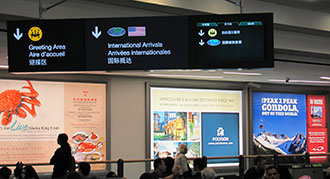Digital Signage Installations: Eight Lessons Learned
By Tracy Robertson
ADFLOW Networks
 With 14 years of experience managing complex digital signage rollouts for some of the largest retailers in North America, we have developed a few best practices along the way. Deploying digital signage is not just hanging screens — it is about integrating the digital experience into the DNA of a store’s design. From considerations around cabling to positioning media players and digital screens, here are some of the lessons we’ve learned that save time and money and ensure our clients get the most value from their investment.
With 14 years of experience managing complex digital signage rollouts for some of the largest retailers in North America, we have developed a few best practices along the way. Deploying digital signage is not just hanging screens — it is about integrating the digital experience into the DNA of a store’s design. From considerations around cabling to positioning media players and digital screens, here are some of the lessons we’ve learned that save time and money and ensure our clients get the most value from their investment.
1. A site survey streamlines the installation process.
Conducting a site survey before the installation identifies the right mount for the solution upfront. For example, in cases when a site survey isn’t done beforehand, the installer may not realize that the media player is going to be mounted on a cement wall, which requires a ceiling mount. The site survey also prevents problems with cabling; we’ve seen situations where clients must redo cabling because they didn’t factor in the impact of other electrical devices in the store and that can be costly.
2. The optimal location boosts the effectiveness of digital signage.
Attracting the attention of shoppers is key to a successful retail digital signage project. Unfortunately, when installing cabling the tendency is to just put the screen close to the power source which isn’t always the optimal location. Even if cables need to be changed or the power moved, it is important to take the time to determine the right screen location for the best impact. Understanding the goals behind the installation of the digital signage helps determine the proper placement. Before you install your screens, ask yourself “what behavior am I trying to encourage with these screens?” This simple question will force you to think through screen placement and store traffic patterns.
3. The right cabling set-up is critical.
When we arrive at locations where someone else has done the installation, often the cables are running here, there and everywhere and nothing is tied down. Cabling shouldn’t look like a spaghetti dinner. Taking the time to meticulously label and tie down each cable so it’s well organized will save time and avoid headaches in the long run. That way if you need to resolve a problem in the future, it’s easier to determine which cable is causing the issue.
4. Purpose-built media players enhance digital signage solutions.
We see people using a regular PC to deploy digital signage and then experiencing jittery content or issues with content that won’t play properly. Using media players that are purpose-built for digital signage and custom-designed for your applications provides greater reliability and better results.
5. All screens are not created equal.
Some people use consumer TVs for their digital signage solutions, however, home TVs are not meant to run 24/7 so they end up failing, which is costly. If you are serious about providing a superior customer experience, it pays to use commercial screens, which are designed to run continuously while maintaining a sharp, high quality picture.
6. Good communication is an essential part of the process.
We do a number of things to keep the lines of communication open including site surveys so everyone is on the same page about the project. Another critical activity we do on all installations is to create a wire diagram using a store layout and architectural drawings to detail the engineer’s designs for the mounting and placement of digital signage. When a technician goes to do the installation, they have a clearly laid-out plan of every engineered detail of the solution. In cases where a company has their own installation team, we provide instructions and direction.
7. A strong project plan helps mitigate risk.
Everyone involved should know what needs to get done, when, how and who is responsible. This will prevent problems such as components not arriving on time. If you are planning renovations, the project manager can coordinate them to dovetail perfectly with the digital signage installation to avoid extra costs. Perfect execution is critical. If a new store has a grand opening, sometimes there is a narrow window to get the installation done.
8. A support team is invaluable for resolving installation issues.
When you encounter issues, having access to a knowledgeable support team is critical. We have a remote online monitoring system that enables us to ensure the media player is working properly before the installation is completed. When issues arise, we can proactively reach out to resolve them before our customers even realize there’s a problem.
Image via Mathew5000 on Wikimedia Commons


